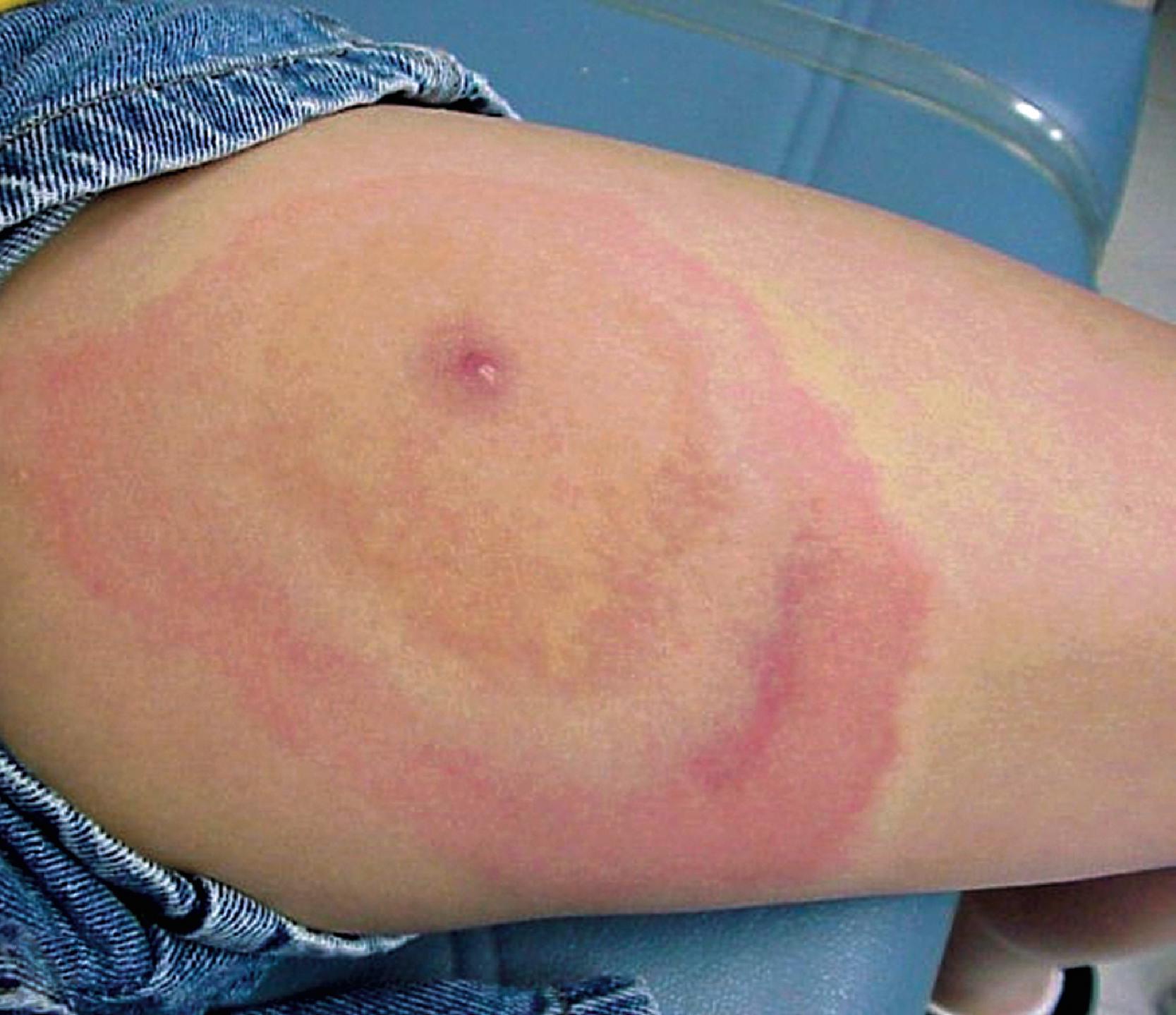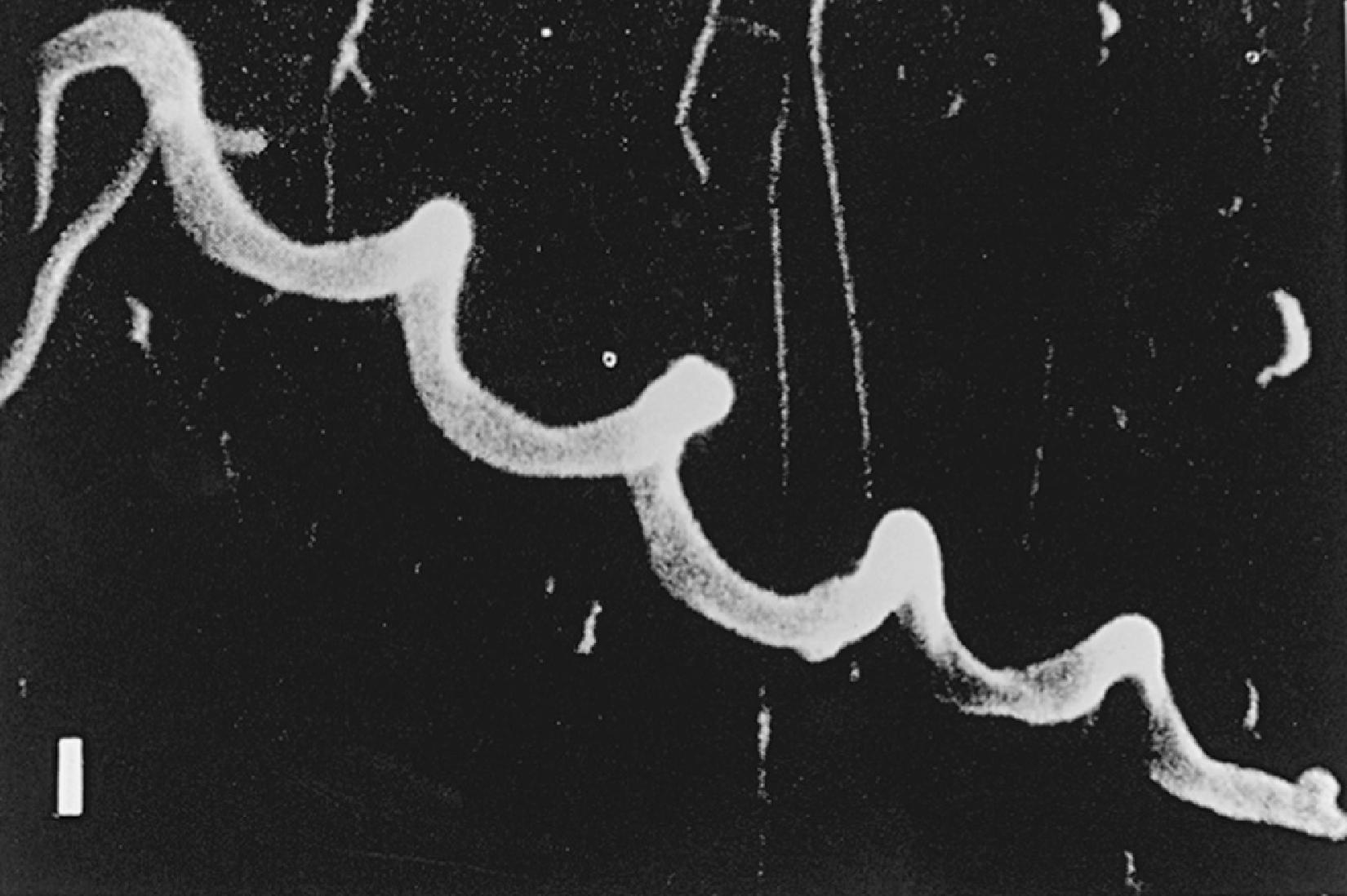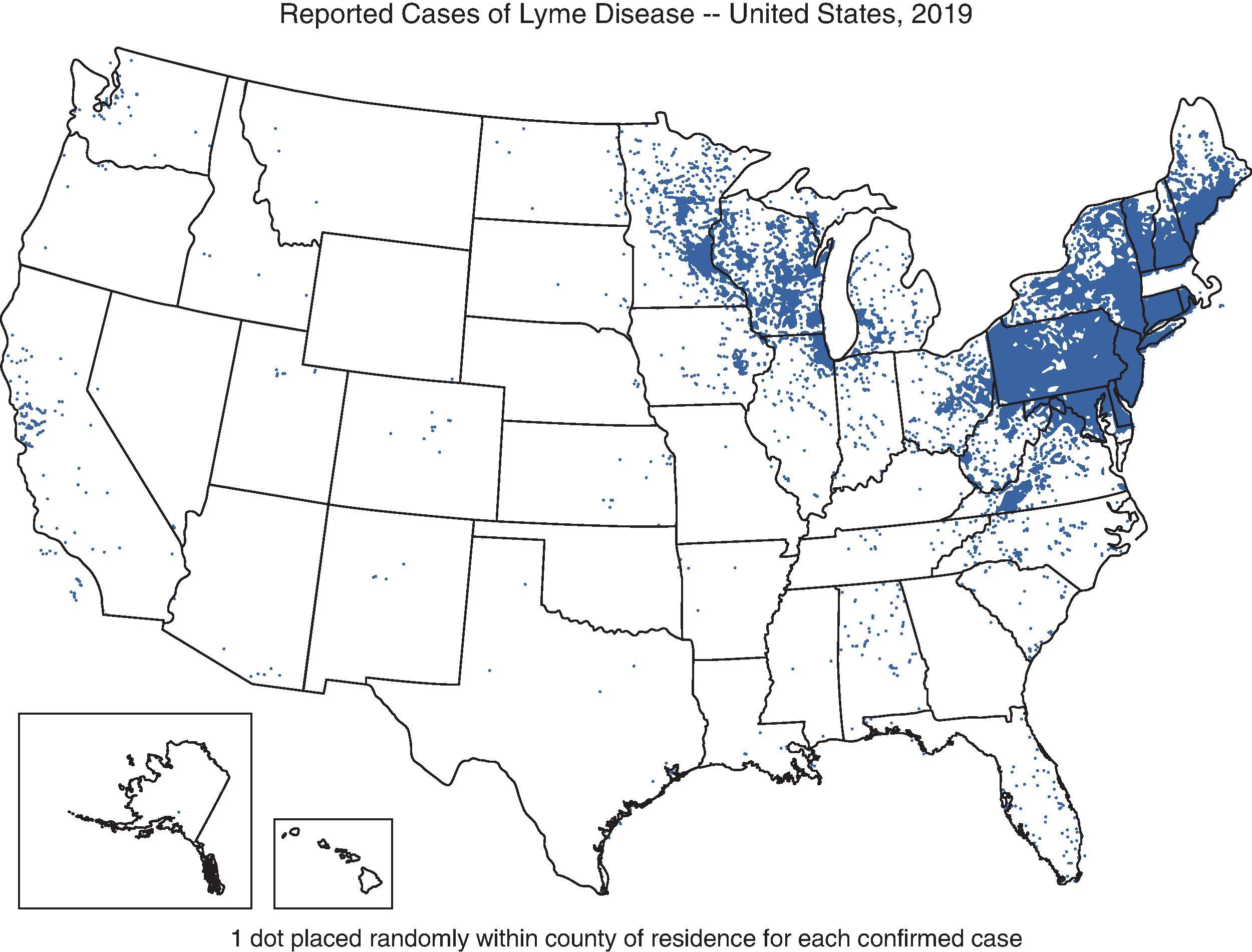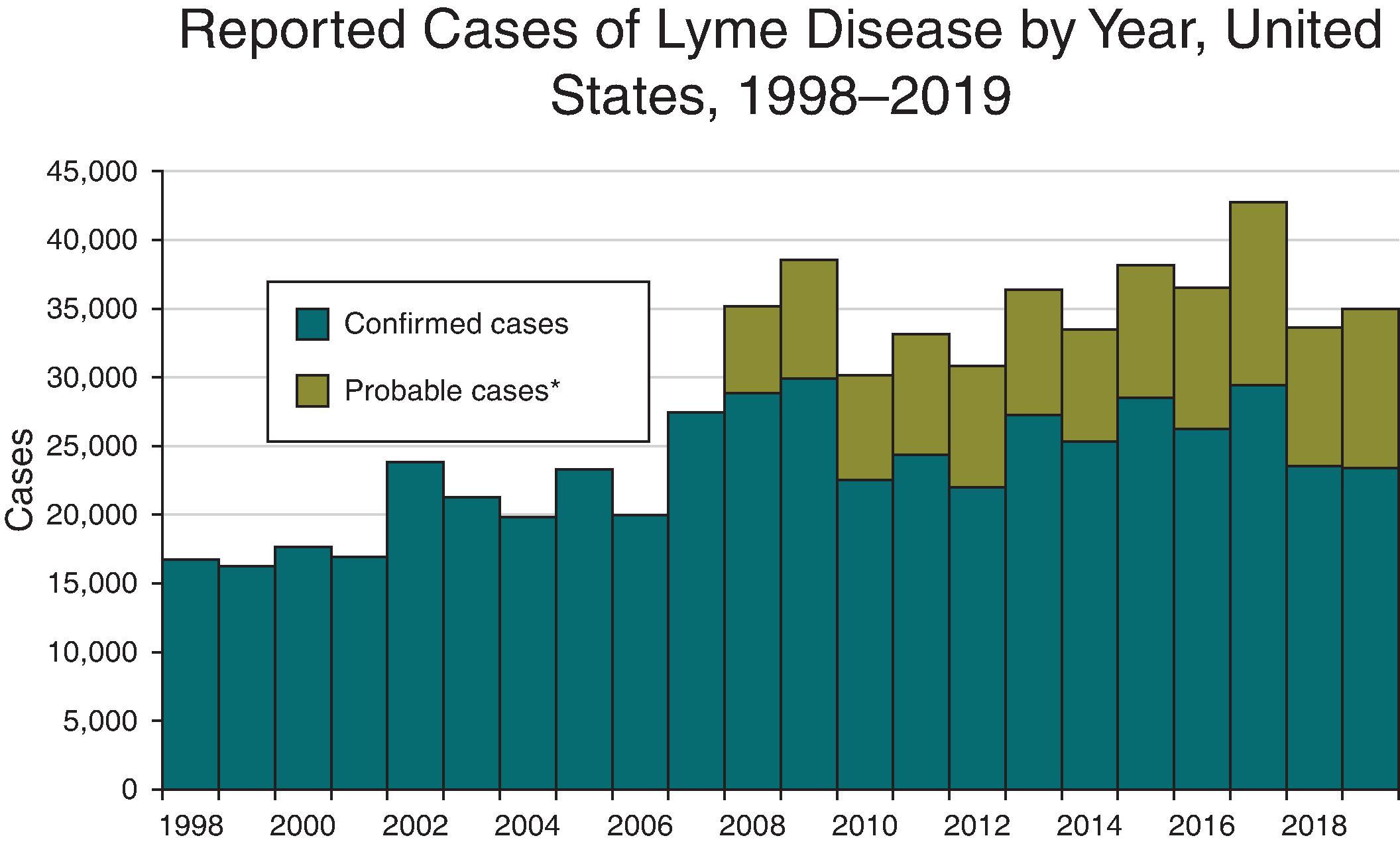Physical Address
304 North Cardinal St.
Dorchester Center, MA 02124
Lyme disease was described as a separate entity in 1976 because of the geographic clustering of a group of children with arthritis in Lyme, Connecticut, who originally were diagnosed as having juvenile rheumatoid arthritis. The rural setting of the case clusters and the identification of an expanding skin lesion, erythema migrans, as a feature of the illness suggested that the disorder was transmitted by an arthropod. It soon became apparent that Lyme disease was a multisystem illness that affected primarily the skin, nervous system, heart, and joints. Epidemiologic studies of patients with erythema migrans implicated certain Ixodid tick species as vectors of the disease.
The etiologic agent is Borrelia burgdorferi sensu lato (sl), which includes a number of different genospecies of the bacteria. In North America the vast majority of cases are caused by B. burgdorferi sensu stricto (ss), with a small number of cases caused by B. mayonii . Although B. burgdorferi ss is also found in Europe, the majority of cases of Lyme disease there are caused by either B. afzelii or B. garinii , although several additional genospecies also cause Lyme disease in Europe. Because of the differences in the etiologic agents, there are differences in some of the clinical manifestations of Lyme disease in Eurasia compared with North America, although in both locations clinical manifestations may involve the skin, the nervous system, the heart, and the joints.
There are different stages of Lyme disease, with different manifestations at each stage. In 70%–80% of patients in the United States, the infection begins with a characteristic localized expanding skin lesion, erythema migrans (stage 1—early localized disease), which occurs at the site of the tick bite. After an incubation period of 3–32 days, redness forms around the site and expands slowly ( Fig. 36.1 ). , In the United States, within days to weeks the causative bacteria, if not exposed to antibiotics, often disseminate hematogenously (stage 2—early disseminated disease). During this period, patients often have non-specific symptoms such as malaise and fatigue, headache, neck pain, arthralgia, myalgia, fever, or regional lymphadenopathy. Secondary annular skin lesions (multiple erythema migrans) are the most common manifestation of this stage of Lyme disease in the United States; other manifestations include carditis, which typically presents with heart block, 11–12,10 or neurologic disease, which may manifest as cranial neuropathy (particularly facial nerve palsy), lymphocytic meningitis, or radiculoneuritis. Neurologic involvement is more common in Europe and in Asia, presumably because of differences in the strains of bacteria that cause Lyme disease there. Even without treatment, these manifestations of the illness usually resolve within weeks to months. Approximately 60% of untreated patients in the northeastern United States will develop intermittent attacks of oligoarticular arthritis, usually in either one or a few large joints at a time, especially the knee, weeks to months after the onset of infection. By the time arthritis is present, the infection often seems localized to affected joints, and systemic symptoms may be minimal. Even in untreated patients, intermittent or persistent Lyme arthritis usually resolves completely within several years.

The structure of Borrelia species, including B. burgdorferi, is similar to that of other spirochetes: a protoplasmic cylinder surrounded by periplasm containing the flagella, which is surrounded, in turn, by an outer membrane ( Fig. 36.2 ). The genome of B. burgdorferi is quite small (approximately 1.5 Mb) and consists of a linear chromosome of 950 kb, as well as nine circular and 12 linear plasmids. , The remarkable aspect of the B. burgdorferi genome is its large number of sequences for predicted or known lipoproteins, including plasmid-encoded outer surface proteins (Osps) A through F. In addition, during early, disseminated infection, a surface-exposed lipoprotein, called VlsE, undergoes extensive antigenic variation. The only known virulence factors of B. burgdorferi are surface proteins, which allow the spirochete to attach to a variety of mammalian cells.

To maintain its complex enzootic cycle, B. burgdorferi must adapt to two markedly different environments, the tick and the mammalian host. In the midgut of the tick, the spirochete expresses outer surface protein A (OspA) and OspB. When a blood meal is taken, these two proteins are downregulated and OspC is upregulated as the spirochete traverses to the tick salivary gland and then to the mammalian host. In the salivary gland, OspC binds a tick protein (Salp15 [saliva protein of 15 kDa]), which protects the spirochete from antibody-mediated killing in the host. In addition, some strains of B. burgdorferi have complement regulator–acquiring surface proteins that bind complement factor H and factor H–like protein 1, which protect the organism from complement-mediated killing.
After transmission from a tick bite, B. burgdorferi usually first multiplies locally in the skin at the site of the bite. Several days later, the spirochete begins to spread in the skin and, within days to weeks, it may disseminate to many sites. A number of mechanisms may aid in dissemination. For example, the sequences of OspC vary considerably among strains, and certain types, particularly OspC type A followed by OspC type I, have enhanced inflammatory potential and can more often be detected in blood. , Spreading through the skin and other tissue matrices may be facilitated by binding of human plasminogen and its activators to the surface of the spirochete. During dissemination and homing to specific sites, the organism attaches to certain host integrins, matrix glycosaminoglycans, and extracellular matrix proteins. Borrelia decorin-binding proteins (Dbps) A and B bind decorin, a glycosaminoglycan on collagen fibrils, which may explain why the organism is commonly aligned with collagen fibrils in the extracellular matrix in the heart, nervous system, or joints.
Both innate and adaptive immune responses, especially macrophage- and antibody-mediated killing, are required for optimal control of the infection and eradication of the spirochetes. The primary role of B. burgdorferi –specific T-helper cells is to prime T-cell–dependent B-cell responses to B. burgdorferi proteins. Consequently, antibodies against many components of the organism are produced, which promote spirochetal killing by opsonization and complement fixation. However, despite innate and adaptive immune responses, the organism may sometimes survive in selected niches for several years. In histologic sections, B. burgdorferi has been seen only extracellularly ; it has not been shown to survive intracellularly for prolonged periods.
B. burgdorferi can be cultured in a complex liquid medium called Barbour-Stoenner-Kelly medium. , However, except for acrodermatitis, a late manifestation of disease in Europe, positive cultures have been obtained only early in the illness, primarily from skin biopsy specimens of erythema migrans lesions, less often from plasma samples, and only occasionally from cerebrospinal fluid samples in patients with meningitis. Later in the infection, polymerase chain reaction (PCR) testing has been used for the detection of B. burgdorferi DNA in joint fluid. , However, because B. burgdorferi DNA at this site is derived from moribund or dead spirochetes, PCR testing of joint fluid is not an accurate indicator of active spirochetal infection. Moreover, PCR testing is not often positive with samples from other sites later in the illness. Thus, the diagnosis of Lyme disease is usually based on recognition of a characteristic clinical picture, potential exposure to ticks in an endemic area, and, except in patients with erythema migrans, a positive antibody response to B. burgdorferi by enzyme-linked immunosorbent assay (ELISA) and Western blot, interpreted according to the criteria of the Centers for Disease Control and Prevention (CDC). In Europe, where there is less expansion of the antibody response, no single set of criteria for the interpretation of immunoblots results in high levels of sensitivity and specificity in all countries.
During the first several weeks of infection, most patients develop erythema migrans; at this time, the sensitivity of antibody tests is low, and they depend primarily on the detection of an IgM response to the spirochete, for which the specificity also is low. However, 4–8 weeks after infection begins, by which time most untreated patients in the United States have developed disseminated infection, both the sensitivity and the specificity of the IgG response to the spirochete are very high, in the range of 95%–99% as determined by the two-tiered test approach of ELISA and Western blot. A positive IgG blot requires reactivity with at least five of the following 10 bands (18, 23, 28, 30, 39, 41, 45, 58, 66, and 93 kDa). In persons who have been ill for longer than 4–6 weeks, a positive IgM test alone is likely to be a false-positive result; therefore, such a response should not be used to support the diagnosis of Lyme disease later than the first 4–6 weeks after infection. An IgG ELISA that uses a peptide in the sixth invariant region of the VlsE lipoprotein of B. burgdorferi (C6 peptide EIA) , may be valuable, as this test typically becomes positive before five IgG bands are present on Western blots. , However, this assay as a stand-alone test is not quite as specific as standard two-tiered testing. In 2019, the Food and Drug Administration (FDA) approved and the CDC endorsed as an alternative to standard two-tiered testing a “modified” two-tiered test approach in which the second step (the Western blot) is replaced by a particular second ELISA test that is a different than the ELISA used for the first tier of the antibody test. ,
Antibody titers fall slowly after antibiotic treatment, but IgG antibodies and even IgM antibodies may persist at low levels for many years after treatment. Moreover, Western blots, a nonquantitative test, do not change much after treatment. Thus, serologic tests can provide evidence of previous exposure to the spirochete, but they cannot distinguish between past infection and active infection. In addition, B. burgdorferi may cause asymptomatic infection.
Overtesting also is a major problem that leads to frequent misdiagnoses of Lyme disease. Even with accurate serologic tests, if the prior probability of Lyme disease in a patient is low, which it is in patients who are in areas in which Lyme disease is not endemic and in patients in any locale who have only non-specific symptoms such as fatigue or pain without objective signs consistent with Lyme disease, the predictive value of a positive antibody test result is very low. , Antibody tests should not be used as screening tests but are indicated only in patients with a reasonably high prior probability of having Lyme disease. Alternate approaches for diagnosis, such as determination of a metabolic biosignature, are being investigated. ,
Lyme disease is a zoonosis, which means that the natural reservoir for the bacteria that cause Lyme disease are animals (i.e., humans are not a reservoir for the bacteria). The natural reservoirs for B. burgdorferi sl are primarily small mammals (particularly mice, chipmunks, voles, hedgehogs, and squirrels) and birds, although other mammals such as foxes and coyotes also may harbor the bacteria. Ixodes ticks become infected by feeding on infected animals and may transmit the bacteria to humans during a subsequent blood meal. In North America, Ixodes scapularis (the black-legged tick, commonly known as the deer tick) is the major vector for the disease. Deer are not competent hosts for the bacteria, but are important for maintaining the life cycle of deer ticks. The small number of cases of Lyme diseases that occur along the Pacific coast are due to transmission by Ixodes pacificus (the Western black-legged tick). In Europe, Lyme borreliae are transmitted by Ixodes ricinus (the sheep tick) and in both Eurasia and Asia by Ixodes persulcatus (the tiaga tick). B. burgdorferi sl is transmitted only by ticks; person-to-person transmission, including via blood transfusion, has not been documented.
In the United States, Lyme disease occurs primarily in the Northeast from Maine to Virginia and in the Midwest in Wisconsin, Minnesota, and parts of Michigan.
In recent years the geographic distribution of Lyme disease has expanded as it has spread to adjacent areas such as western Pennsylvania, eastern, and central Ohio, northern North Carolina, and southern Canada ( Fig. 36.3 ).

Since surveillance for Lyme disease was begun in the United States in 1982, the number of cases reported to the CDC has increased substantially. In recent years, more than 30,000 cases have been reported yearly, accounting for more than 95% of all reported cases of vector-borne illnesses in the United States. A table of reported cases of Lyme disease in the United States is shown in Fig. 36.4 . However reported cases are thought to be a substantial underestimate. It is estimated that approximately 476,000 cases of Lyme disease occurred in the United States annually from 2010 to 2018. Increases in the deer population (largely as a result of changes in landscape ecology), which are the preferred host of adult I. scapularis , is a major factor in the emergence of epidemic Lyme disease in the eastern and north central United States.

Unlike in the United States, where surveillance for Lyme disease has been well established for many years, in Europe reporting and surveillance generally is not standardized so it is more difficult to estimate the burden of the disease. Incidence appears to be highest in southern Scandinavia and in central Europe. , The distribution of Lyme disease in Europe closely follows the distribution of Ixodes ricinus which is shown in Fig. 36.5. The infection also occurs in Russia, China, and Japan
In the absence of a vaccine, prevention of Lyme disease in humans relies on reducing or eliminating tick bites. , Also, because there is a delay from the time that a tick attaches until transmission of B. burgdorferi sl, simply removing an attached tick can also reduce the chance of becoming infected. Personal protective measures include avoiding tick-infested areas, covering up skin as much as possible, wearing light colored clothing (to more easily spot ticks), using insect repellents on exposed skin except for the hands and face, bathing within 2 hours after potential exposure to ticks, total body checks for ticks at least every 24 hours, and placing clothing potentially exposed to ticks in a dryer under high heat for at least 10 minutes. The acaricide permethrin, which is highly toxic to arthropods but nontoxic to mammals (other than cats), may be applied to clothing but not to skin, using the directions provided by the manufacturer; alternatively, pretreated clothing may be purchased. The active ingredient binds tightly to fabric, and may retain tick-killing activity for a dozen or more wash cycles.
Ticks attached to skin should be promptly removed using forceps or tweezers, grasping as close to the skin as possible and pulling firmly. The site of the bite should be disinfected. Individuals of any age with a high-risk Ixodes tick bite, meaning the tick was encountered in an area highly endemic for Lyme disease and was likely attached for at least 36 hours, may be treated with a single dose of doxycycline to prevent the development of Lyme disease. In fact, single-dose doxycycline for postexposure prophylaxis after a high-risk tick bite has been endorsed by the Infectious Diseases Society of America (IDSA). Clinical trials have demonstrated that single-dose doxycycline is effective for prevention of Lyme disease after a tick bite in both the United States and Europe. Aggregated data from these two trials on the use of single-dose doxycycline for postexposure prophylaxis indicated an overall efficacy for prevention of Lyme disease after a recognized tick bite of 71% (95% CI: 40%–86%). ,
Development of immunity and the cellular and serologic response to infection with B. burgdorferi has been well described, particularly in mouse models, but also in humans. Most patients have symptoms of the infection for months before protective immunity develops. Administration of a humanized OspA-specific, borreliacidal monoclonal antibody to provide OspA antibody can prevent infection in animal models of Lyme disease. , When passively administered to mice prior to challenge with infected ticks, these humanized monoclonal antibodies completely prevented transmission of B. burgdorferi ss. Clinical trials in humans are underway. If found to be safe and effective, this approach could be a means to reliably provide neutralizing antibody to patients, and it would avoid the problem of variation in the response to immunization among patients. To assure adequate circulating neutralizing antibody to prevent Lyme disease, administration of the OspA antibody preparation would be needed each year prior to the season when ticks become active. Some of the humanized OspA antibodies raised against full-length OspA of B. burgdorferi ss bind to a novel epitope that appears to provide protection against a broader array of genotypes, such as B. afzelii. , In addition, the expectation is that the monoclonal antibody will be administered subcutaneously, rather than intravenously, which should lead to a larger number of venues able to administer the antibody.
Become a Clinical Tree membership for Full access and enjoy Unlimited articles
If you are a member. Log in here